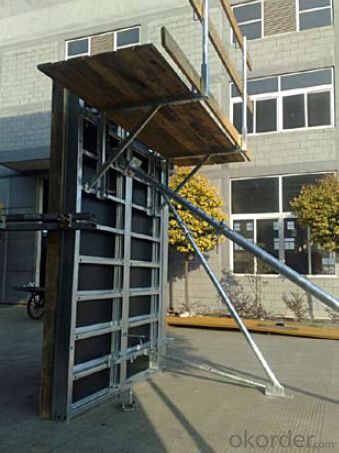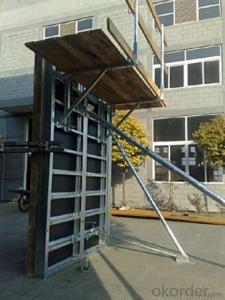Steel-frame Formwork working platform
- Loading Port:
- China Main Port
- Payment Terms:
- TT OR LC
- Min Order Qty:
- -
- Supply Capability:
- -
OKorder Service Pledge
OKorder Financial Service
You Might Also Like
Steel-frame Formwork SF-140
Characteristics:
◆ Few parts for fast forming.
◆ Max. Concrete pressure: 80KN/m2.
◆ Hot-dip galvanized steel frame.
◆ The thickness of plywood is 18mm & the panel is 14cm.
◆ Compatibility with Hunnebeck Manto system due to similar edge profile.
System Details & Application:
◆ Neat joint and fast assembling with aligning panel clamp.
◆ Flexible panel arrangement and height extension.
◆ The selection of panels.
◆ Kinds of panel connectors.
◆ Corner clamp application.
◆ Length adjustment application.
◆ Height adjustment & aligning strut.
◆ Walkway bracket & platform.
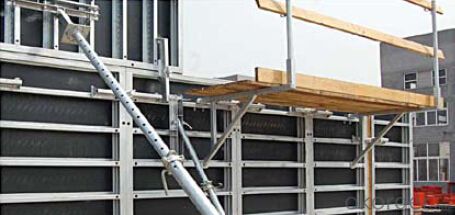
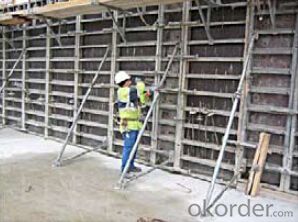
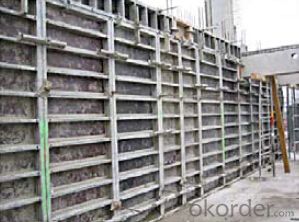
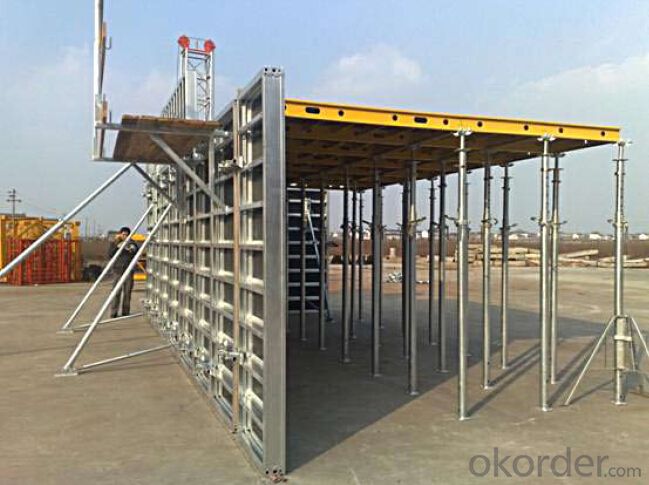
- Q: Can steel formwork be used for curved or irregular shapes?
- Yes, steel formwork can be used for curved or irregular shapes. Steel is a highly flexible material that can be easily manipulated to create various shapes and sizes. It offers excellent strength and durability, making it suitable for withstanding the pressure exerted by concrete during pouring and curing. To form curved or irregular shapes, steel formwork is usually fabricated using modular panels that can be adjusted or bent to the desired shape. These panels can be easily connected together to form a continuous surface. Additionally, steel formwork can be customized and welded to create complex shapes that perfectly match the architectural design requirements. The versatility of steel formwork allows it to be used for a wide range of projects, including buildings, bridges, tunnels, and dams. It provides a high-quality finish and can be reused multiple times, making it a cost-effective solution for projects that require repetitive shapes or structures with unique geometries. In conclusion, steel formwork is an excellent choice for creating curved or irregular shapes. Its flexibility, strength, and durability make it a reliable option for construction projects that require complex and customized formwork solutions.
- Q: Can steel formwork be used for office building construction projects?
- Yes, steel formwork can be used for office building construction projects. Steel formwork is a versatile and durable option for concrete construction that offers many advantages. It provides a high level of strength and stability, allowing it to withstand the pressures and loads encountered during the construction process. Steel formwork is also reusable, which makes it a cost-effective choice for large-scale projects like office buildings. Additionally, steel formwork allows for quick and efficient construction, as it can be easily assembled and disassembled, enabling faster turnaround times. Overall, steel formwork is a suitable option for office building construction projects due to its strength, durability, cost-effectiveness, and efficiency.
- Q: What are the common quality control measures for steel formwork systems?
- Steel formwork systems commonly undergo several quality control measures to ensure their effectiveness and safety in construction projects. These measures include: 1. Visual assessment: A thorough examination of the steel formwork system's condition is conducted to identify any noticeable defects, such as dents, cracks, or deformations. Damaged or compromised components must be promptly repaired or replaced. 2. Measurement and dimensional verification: Ensuring accurate measurements and dimensional alignment of steel formwork components is crucial. This is achieved by utilizing precise measuring tools and equipment to guarantee a proper fit. 3. Inspection of welded joints: Since welded joints are often used to connect various components of steel formwork systems, it is vital to conduct comprehensive inspections to detect any defects, like cracks or incomplete penetration. Non-destructive testing methods, such as visual inspection, ultrasonic testing, or magnetic particle testing, may be employed to evaluate the weld quality. 4. Load testing: To validate the structural integrity and load-bearing capacity, load testing is performed. This procedure involves applying a predetermined load to the system and evaluating its performance under stress. It helps identify any weaknesses or defects that could compromise the formwork's safety and stability. 5. Examination of surface finish: The surface finish of steel formwork systems must be smooth and devoid of roughness or irregularities that could affect the quality of the concrete finish. Inspections are carried out to ensure that the formwork surfaces are adequately cleaned, treated, and coated, if necessary. 6. Documentation and traceability: It is imperative to maintain proper documentation and traceability of the steel formwork system components. This includes keeping records of inspections, repairs, replacements, and other pertinent information. Proper documentation ensures timely and accurate resolution of any issues or concerns that may arise. These quality control measures are indispensable for guaranteeing the durability, safety, and performance of steel formwork systems in construction projects.
- Q: Can steel formwork be used for pre-stressed concrete elements?
- Pre-stressed concrete elements can indeed utilize steel formwork. Steel formwork is an adaptable and long-lasting alternative for the construction of such elements. It provides the necessary support and containment for the concrete throughout the pre-stressing process, ensuring the maintenance of its shape and strength. The suitability of steel formwork for pre-stressed concrete elements is due to its ability to bear substantial loads and withstand the forces and pressures involved in the pre-stressing process. Additionally, it enables precise control over the form and dimensions of the concrete element, guaranteeing accurate and consistent outcomes. Moreover, steel formwork is reusable, making it a cost-effective option for pre-stressed concrete construction projects. It can be easily assembled, disassembled, and adjusted to accommodate various shapes and sizes of pre-stressed elements. In conclusion, steel formwork is a suitable and commonly employed choice for the construction of pre-stressed concrete elements because of its strength, versatility, and cost-effectiveness.
- Q: Can steel formwork be used for bridge construction?
- Yes, steel formwork can be used for bridge construction. Steel formwork offers several advantages such as high strength, durability, and reusability, making it suitable for constructing bridge components like beams, columns, and decks. It provides a stable and rigid structure that can withstand heavy loads and adverse weather conditions, ensuring the safety and longevity of the bridge.
- Q: Can steel formwork be used for suspended slabs?
- Yes, steel formwork can be used for suspended slabs. Steel formwork offers high strength and durability, making it suitable for supporting the weight of the concrete and reinforcing bars in suspended slab construction. It provides a stable and secure platform for pouring concrete, ensuring proper alignment and smooth finishing of the slab. Additionally, steel formwork can be easily reassembled and reused, making it a cost-effective option for suspended slab applications.
- Q: Is steel formwork suitable for all types of concrete structures?
- No, steel formwork may not be suitable for all types of concrete structures. While steel formwork is versatile and durable, it may not be cost-effective or practical for smaller projects or structures with complex designs. Additionally, certain conditions such as extreme temperatures, corrosive environments, or high-rise buildings may require alternative formwork systems. Therefore, the suitability of steel formwork depends on the specific project requirements and considerations.
- Q: How does steel formwork handle different concrete mix designs?
- Steel formwork is known for its versatility and ability to effectively handle different concrete mix designs. The strength and durability of steel make it a suitable choice for accommodating a wide range of concrete mixes. One advantage of using steel formwork is its capability to withstand the pressure and weight of various concrete mix designs. Whether it is a high-strength mix or a mix with a higher water-cement ratio, steel can handle the load without any deformation or collapse. This makes it perfect for projects that require customized concrete mixes. Moreover, steel formwork ensures a smooth and even surface finish for concrete structures, regardless of the mix design. This is essential for achieving the desired aesthetic appearance of the finished product. Steel formwork guarantees that the concrete is properly contained, preventing any leaks or spills during the pouring process, resulting in a consistent and uniform finish. Additionally, steel formwork can be easily adjusted or modified to accommodate changes in concrete mix designs. Its adaptability allows for efficient construction processes and reduces the need for additional formwork materials. In summary, steel formwork is a reliable and efficient choice for handling different concrete mix designs. Its strength, durability, and adaptability make it an ideal solution for construction projects that require customized concrete mixes. Whether it is a high-strength mix or a mix with specific properties, steel formwork can effectively handle the demands of various concrete designs.
- Q: What is the difference between the steel template and the wood template? When to use steel formwork? When to use a wooden template?Now what kind of use
- Wood template is artificial site processing, the use of a variety of complex structural modeling, and now use the glue template is also a lot, in addition to good heat dissipation of steel templates, the use of large steel formwork is good
- Q: Can steel formwork be used for both cast-in-place and precast concrete construction?
- Both cast-in-place and precast concrete construction can utilize steel formwork. The versatility of steel formwork allows for easy adjustments and modifications to accommodate different construction techniques. In cast-in-place construction, steel formwork is commonly employed to create temporary molds that secure the liquid concrete until it solidifies and gains strength. Once the concrete sets, the formwork can be removed and reused for subsequent pours. For precast concrete construction, steel formwork is utilized to establish permanent molds that shape the concrete components off-site. These precast elements are then transported to the construction site and installed as part of the overall structure. Steel formwork exhibits remarkable durability, capable of withstanding the immense pressures and forces involved in precast concrete construction. In summary, steel formwork boasts numerous advantages, including strength, durability, reusability, and adaptability. This makes it well-suited for both cast-in-place and precast concrete construction methods.
Send your message to us
Steel-frame Formwork working platform
- Loading Port:
- China Main Port
- Payment Terms:
- TT OR LC
- Min Order Qty:
- -
- Supply Capability:
- -
OKorder Service Pledge
OKorder Financial Service
Similar products
Hot products
Hot Searches
Related keywords



